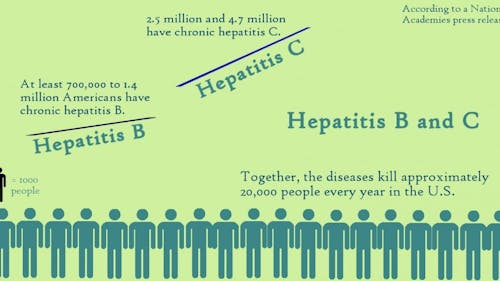Rutgers Chancellor produces paper analyzing hepatitis B, C

Lack of public awareness regarding hepatitis and its effects may attribute to the many deaths still occurring in the United States today.
Hepatitis B is particularly much less common in the U.S. than in other countries, said Brian Strom, chancellor of Rutgers Biomedical and Health Sciences.
"Asia and Africa have much higher rates of hepatitis B," he said. "That’s why they have higher rates of liver cancer. Previously, we hadn’t known why, but now we do."
Despite U.S. rates being lower than rates of other countries, steps need to be taken to lower those numbers in order to save lives, Strom said.
About 700,000 to 1.4 million Americans have chronic hepatitis B, and between 2.5 million and 4.7 million Americans have chronic hepatitis C, according to a National Academies press release.
"Together, the diseases kill approximately 20,000 people every year in the U.S.," according to the press release.
Last week, frozen berry retailer Nature's Touch recalled its "Organic Berry Cherry Blend" sold at Costco stores in Canada after being linked to a hepatitis outbreak, according to Food Safety News. Twelve people were confirmed with Hepatitis A, and three required hospitalization.
Costco is now offering free hepatitis A shots to anyone in Ottawa and Gatineau that bought the contaminated berries, and will be offering the shots for a week, according to the Ottawa Sun.
Hepatitis A is much less serious than hepatitis B and C because it can be managed, Strom said. Much fewer people die from hepatitis A than from B and C.
“Hepatitis B and C aren’t illnesses where you get a little sick and then get better. People really do badly. Society needs to pay more attention to this,” Strom said.
Contraction of hepatitis differs between each type, he said.
Hepatitis A is fecal-oral. Victims can contract it from the spread of contaminated stool or contaminated food. It can also be contracted from very close personal contact, Strom said.
Hepatitis B comes from the passage of blood, he said.
"A mother can pass it down to her child. If someone for whatever reason gets an injection from a dirty needle, it can also be contracted," Strom said.
Hepatitis can be asymptomatic or it can seem like a cold, he said. A patient can turn yellow and experience jaundice because their liver is experiencing issues and is not functioning properly.
“But over time, chronic hepatitis causes cirrhosis, which is scarring of the liver. It can get sufficiently severe and the liver will stop working, and you can develop liver disease and need a liver transplant,” Strom said.
There are blood tests that people can take in order to find out whether or not they have hepatitis. The tests are fairly accurate in determining this, Strom said.
“There is a vaccine for hepatitis A. There is also a very effective vaccine for hepatitis B, and it’s recommended for all infants or infected mothers. There is not a vaccine for hepatitis C. It just hasn’t been developed yet," he said. "The existence of hepatitis C is newer. It is being worked on, though."
It is possible to greatly decrease the chance of an individual not only contracting hepatitis, but from developing liver cancer as well by making lifestyle changes to Strom said.
“Close to 80 percent of all liver cancer, which is a hard to treat kind of cancer, is caused by hepatitis B and C," he said. "So if we were to prevent hepatitis B and C, we would prevent most liver cancer in the country. We’d also prevent a large proportion of transplants, since they would no longer be needed.”
Some ways to prevent hepatitis include abstaining from having unprotected sex with infected individuals and refraining from sharing needles. Although we are in no way advocating the abuse of drugs, if you do use needles, make sure that they are sterile, Strom said.
“Hepatitis C can be cured, and curing infected injection drug users could reduce transmission and elicit a drop in disease prevalence of 20 percent to 80 percent… Preventing substance use disorders in the first place also could lower transmission by reducing the number of people at risk for contracting the virus,” according to the press release.
In the earlier stages, living with hepatitis is uncomfortable but not difficult, he said.
In the middle when it’s asymptomatic and it’s manageable, but in the end stage, people get liver disease, cirrhosis and develop liver cancer.
There are definitely a lot of problems in the way of us achieving total eradication of hepatitis B and C — but it is possible, Strom said.
About two-thirds of people with chronic hepatitis B and half of people with chronic hepatitis C do not know they are infected, according to the press release.
People newly infected with hepatitis C tend to be poorer and less educated than average, which can make them harder to screen because they have less contact with the health system, according to the press
One of the reasons Strom and his committee wrote "A National Strategy on the Elimination of Hepatitis B and C – Phase 1" was to draw societal attention to an issue that is very concerning.
In their next report, they will provide recommendations for solutions to the problems. Hopefully by the time it is released, people will care more about hepatitis, Strom said.
“Liver cancer is a preventable cancer, but there are more people that die of hepatitis than die of HIV (or) AIDS. And yet there’s enormous attention for HIV/AIDS, and not as much for hepatitis," Strom said. "Our hope is to draw publicity from the report to bring awareness."
Nicole Osztrogonacz is a School of Arts and Sciences first-year student majoring in English. She is a staff writer for The Daily Targum. Find her on Twitter @nikki_osz for more.



